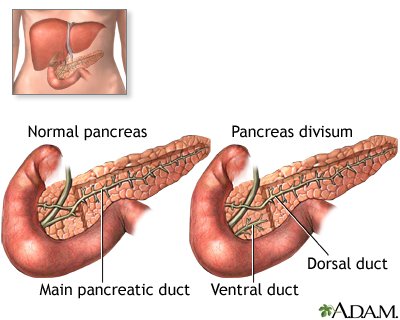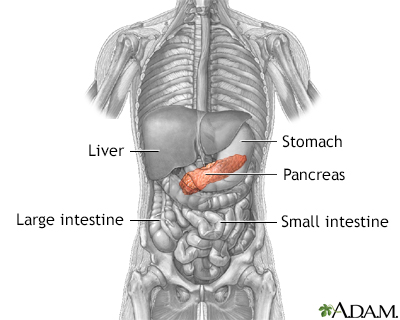Pancreas divisum
Pancreas divisum is a birth defect in which parts of the pancreas do not join together. The pancreas is a long, flat organ located between the stomach and spine. It helps in food digestion.
Causes
Pancreas divisum is the most common birth defect of the pancreas. In many cases, this defect goes undetected and causes no problems. The cause of the defect is unknown.
As a baby develops in the womb, two separate pieces of tissue join together to form the pancreas. Each part has a tube, called a duct. When the parts join together, a final duct, called the pancreatic duct, is formed. Fluid and digestive juices (enzymes) produced by the pancreas normally flow through this duct.
Pancreas divisum occurs if the ducts do not join while the baby develops. Fluid from the two parts of the pancreas drains into separate areas of the upper portion of the small intestine (duodenum). This occurs in 5% to 15% of people.
If a pancreatic duct becomes blocked, swelling and tissue damage (pancreatitis) may develop.
Symptoms
Many people do not have any symptoms. If you have pancreatitis, symptoms include:
- Abdominal pain, most often in the upper abdomen that may be felt in the back
Abdominal pain
Abdominal pain is pain that you feel anywhere between your chest and groin. This is often referred to as the stomach region or belly.
 ImageRead Article Now Book Mark Article
ImageRead Article Now Book Mark Article - Abdominal swelling (distention)
Abdominal swelling
A swollen abdomen is when your belly area is bigger than usual.
Read Article Now Book Mark Article - Nausea or vomiting
Exams and Tests
You may have the following tests:
- Abdominal ultrasound
Abdominal ultrasound
Abdominal ultrasound is a type of imaging test. It is used to look at organs in the abdomen, including the liver, gallbladder, spleen, pancreas, and...
 ImageRead Article Now Book Mark Article
ImageRead Article Now Book Mark Article - Abdominal CT scan
Abdominal CT scan
An abdominal CT scan is an imaging method. This test uses x-rays to create cross-sectional pictures of the belly area. CT stands for computed tomog...
 ImageRead Article Now Book Mark Article
ImageRead Article Now Book Mark Article - Amylase and lipase blood test
Amylase
Amylase is an enzyme that helps digest carbohydrates. It is made primarily in the pancreas and the glands that make saliva, and can be found at low ...
 ImageRead Article Now Book Mark Article
ImageRead Article Now Book Mark ArticleLipase
Lipase is a protein (enzyme) released by the pancreas into the small intestine. It helps the body absorb fat. This test is used to measure the amou...
 ImageRead Article Now Book Mark Article
ImageRead Article Now Book Mark Article - Endoscopic retrograde cholangiopancreatography (ERCP)
- Magnetic resonance cholangiopancreatography (MRCP)
- Endoscopic ultrasound (EUS)
Treatment
The following treatments may be needed if you have symptoms of the condition, or if pancreatitis keeps returning:
- ERCP with a cut to enlarge the opening where the pancreatic duct drains
- Placement of a stent to prevent the duct from getting blocked
You may need surgery if these treatments do not work.
Outlook (Prognosis)
Most of the time, the outcome is good.
Possible Complications
The main complication of pancreas divisum is pancreatitis.
When to Contact a Medical Professional
Contact your health care provider if you develop symptoms of this disorder.
Prevention
Because this condition is present at birth, there is no known way to prevent it.
Reviewed By
Michael M. Phillips, MD, Emeritus Professor of Medicine, The George Washington University School of Medicine, Washington, DC. Also reviewed by David Zieve, MD, MHA, Medical Director, Brenda Conaway, Editorial Director, and the A.D.A.M. Editorial team.
Adams DB, Cote GA. Pancreas divisum and other variants of dominant dorsal duct anatomy. In: Cameron AM, Cameron JL, eds. Current Surgical Therapy. 13th ed. Philadelphia, PA: Elsevier; 2020:515-521.
Kumar V, Abbas AK, Astre JC. Pancreas. In: Kumar V, Abbas AK, Aster JC, eds. Robbins Basic Pathology. 10th ed. Philadelphia, PA: Elsevier; 2018:chap 17.
Mehta MS, Barth BA, Husain SZ. Anatomy, histology, embryology and developmental anomalies of the pancreas. In: Feldman M, Friedman LS, Brandt LJ, eds. Sleisenger and Fordtran's Gastrointestinal and Liver Disease: Pathophysiology/Diagnosis/Management. 11th ed. Philadelphia, PA: Elsevier; 2021:chap 55.




 All rights reserved.
All rights reserved.